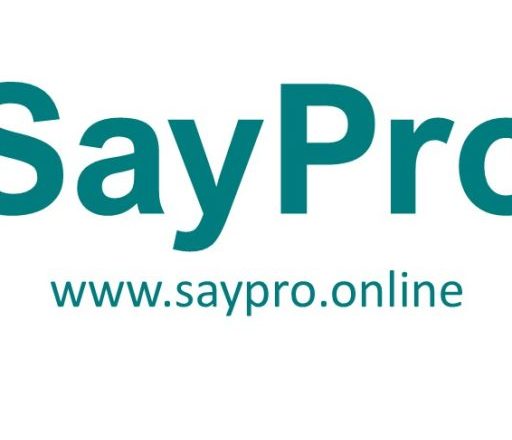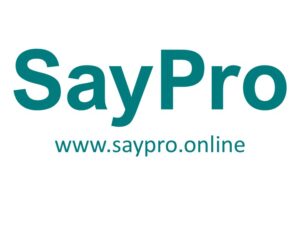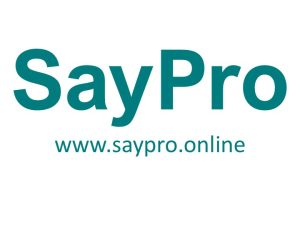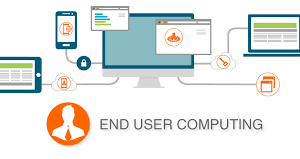SayPro Online Course in Business Writing
- Description
- Curriculum
- Reviews
- Grade
This practical, hands-on course is designed to help professionals at all levels master the essential skills of clear, concise, and effective business writing. Through real-world examples, interactive exercises, and personalized feedback, participants will learn to craft emails, reports, proposals, and other documents that get results.
Key Learning Outcomes:
By the end of this course, participants will be able to:
✔ Write clear, professional emails that get read and acted upon
✔ Structure reports and proposals for maximum impact
✔ Adapt tone and style for different audiences and purposes
✔ Apply editing techniques to eliminate errors and improve clarity
✔ Use business writing best practices to save time and avoid miscommunication
Course Format:
-
Duration: 4 weeks (self-paced) or 2-day intensive workshop
-
Deliverables: Real-world writing samples, personalized feedback, templates
-
Assessment: Practical assignments, peer reviews, final capstone project
Who Should Take This Course:
-
Professionals who want to write with more confidence and clarity
-
Managers who need to communicate complex ideas simply
-
Teams looking to standardize their business writing
-
Anyone who writes emails, reports, or proposals as part of their job
Bonus Materials:
-
Templates for common business documents
-
Checklists for editing and proofreading
-
Style guide with best practices
Enroll today and transform your business writing from good to great!
This description highlights:
✅ Practical value (skills you can use immediately)
✅ Clear outcomes (what you’ll be able to do)
✅ Engaging format (interactive and hands-on)
✅ Audience focus (who will benefit most)
-
11.1 CONTACT DETAILSText lesson
-
21.2 COMPETENCEText lesson
-
31.3 ASSESSMENT STRATEGYText lesson
-
41.4 ASSESSMENT PREPARATIONText lesson
-
51.5 AGREED ASSESSMENT PLANText lesson
-
61.6 Interview (RPL Purposes)Text lesson
-
71.7 LETTER OF COMMITMENT FROM THE LEARNERText lesson
-
81.8 Declaration of AuthenticityText lesson
-
91.9 PORTFOLIO BUILDINGText lesson
-
101.10 RECORD OF LEARNINGText lesson
-
111.11 ASSESSMENT DECISION & EVIDENCE EVALUATION RECORDText lesson
-
121.12 Assessor’s feedback report to the candidateText lesson
-
131.13 Moderator’s ReportText lesson
-
141.14 ASSESSMENT REVIEWText lesson
-
151.15 Candidate Appeal FormText lesson
-
161.16 Assessor's Contingency PlanText lesson
-
172.1 SayPro Lesson in The Foundations of Effective Business WritingText lesson
-
182.2 SayPro Lesson in Crafting High-Impact Business EmailsText lesson
-
192.3 SayPro Lesson in The Strategic Report FrameworkText lesson
3.2 The Strategic Report Framework
The S.T.A.R. methodology (Situation, Task, Analysis, Recommendation) provides a proven structure:-
Situation Analysis
-
Context setting with relevant background
-
Current state assessment using data visualization
-
Example: A sales performance report might open with market share trends
-
-
Task Clarification
-
Explicit statement of the report's purpose
-
Alignment with organizational objectives
-
Case study: How Boeing's operational reports reduced project delays by 22%
-
-
Analytical Depth
-
Layered analysis approach (executive → detailed)
-
Evidence weighting system for key findings
-
Psychological principle: Miller's Law of 7±2 data points
-
-
Recommendation Development
-
Option evaluation matrix
-
Risk assessment framework
-
Real-world example: Pfizer's vaccine distribution report structure
-
3.3 Data Storytelling Techniques
The McKinsey approach to quantitative storytelling:-
Narrative Flow
-
Dramatic arc in business contexts
-
Transitional phrasing that guides readers
-
-
Visual Hierarchy
-
Eye-tracking optimized layouts
-
Color theory applications for emphasis
-
-
Executive Summary Perfection
-
The 1-3-9 rule (1 page, 3 takeaways, 9 supporting points)
-
Annotated example from Amazon's annual report
-
-
-
202.4 SayPro Lesson in Persuasive Business ProposalsText lesson
-
212.5 SayPro Lesson in Executive Summaries and BriefsText lesson
-
222.6 SayPro Lesson in Technical Writing for BusinessText lesson
-
232.7 SayPro Lesson in Cross-Cultural Business CommunicationText lesson
-
242.8 SayPro Lesson in Writing for Digital PlatformsText lesson
-
252.9 SayPro Lesson in Editing and Quality ControlText lesson
-
262.10 SayPro Lesson in Developing Your Professional VoiceText lesson

Recent Posts
- SayPro Strengthen SayPro’s academic footprint through quarterly knowledge innovation.
- SayPro Equip SayPro learners and professionals with niche, in-demand, and emerging competencies.
- SayProCHAR-Daily Activity by Dorah Radebe SayPro Training Specialist for 04 July 2025
- SayProCHAR Daily Activity Report By Phidelia Dube Education Officer 04 July 2025
- SayProCHAR – Daily Activity Report by Linda Tivane – Education Specialist – 04 July 2025


